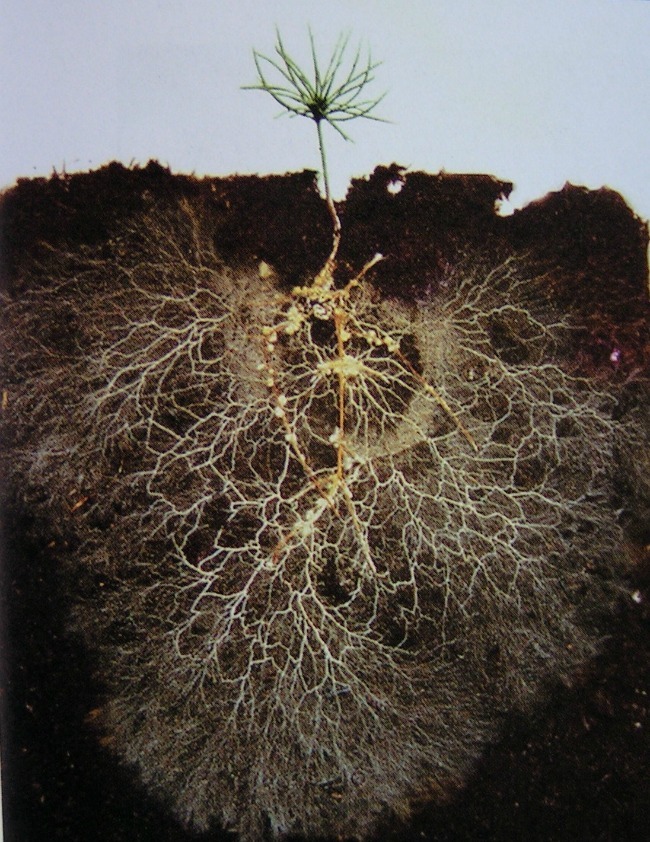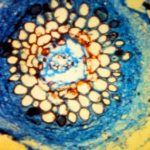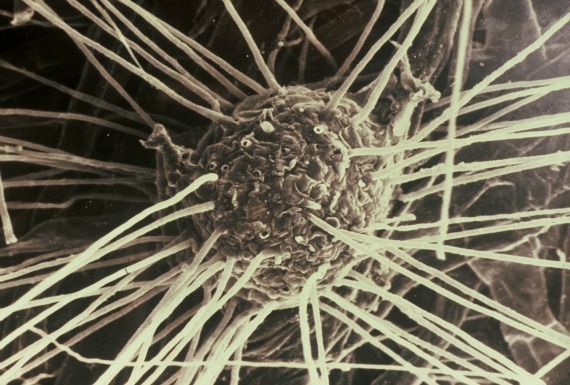The Atlantic: Healthy Soil Microbes, Healthy People

by Mike Amaranthus and Bruce Allyn | Jun 11, 2013
The microbial community in the ground is as important as the one in our guts.
A small pine tree grown in a glass box reveals the level of white, finely branched mycorrhizal threads or “mycelium” that attach to roots and feed the plant. (David Read)
We have been hearing a lot recently about a revolution in the way we think about human health — how it is inextricably linked to the health of microbes in our gut, mouth, nasal passages, and other “habitats” in and on us. With the release last summer of the results of the five-year National Institutes of Health’s Human Microbiome Project, we are told we should think of ourselves as a “superorganism,” a residence for microbes with whom we have coevolved, who perform critical functions and provide services to us, and who outnumber our own human cells ten to one. For the first time, thanks to our ability to conduct highly efficient and low cost genetic sequencing, we now have a map of the normal microbial make-up of a healthy human, a collection of bacteria, fungi, one-celled archaea, and viruses. Collectively they weigh about three pounds — the same as our brain.
Now that we have this map of what microorganisms are vital to our health, many believe that the future of healthcare will focus less on traditional illnesses and more on treating disorders of the human microbiome by introducing targeted microbial species (a “probiotic”) and therapeutic foods (a “prebiotic” — food for microbes) into the gut “community.” Scientists in the Human Microbiome Project set as a core outcome the development of “a twenty-first century pharmacopoeia that includes members of the human microbiota and the chemical messengers they produce.” In short, the drugs of the future that we ingest will be full of friendly germs and the food they like to eat.
The single greatest leverage point for a sustainable and healthy future for the seven billion people on the planet is arguably immediately underfoot: the living soil, where we grow our food.
But there is another major revolution in human health also just beginning based on an understanding of tiny organisms. It is driven by the same technological advances and allows us to understand and restore our collaborative relationship with microbiota not in the human gut but in another dark place: the soil.
Just as we have unwittingly destroyed vital microbes in the human gut through overuse of antibiotics and highly processed foods, we have recklessly devastated soil microbiota essential to plant health through overuse of certain chemical fertilizers, fungicides, herbicides, pesticides, failure to add sufficient organic matter (upon which they feed), and heavy tillage. These soil microorganisms — particularly bacteria and fungi — cycle nutrients and water to plants, to our crops, the source of our food, and ultimately our health. Soil bacteria and fungi serve as the “stomachs” of plants. They form symbiotic relationships with plant roots and “digest” nutrients, providing nitrogen, phosphorus, and many other nutrients in a form that plant cells can assimilate. Reintroducing the right bacteria and fungi to facilitate the dark fermentation process in depleted and sterile soils is analogous to eating yogurt (or taking those targeted probiotic “drugs of the future”) to restore the right microbiota deep in your digestive tract.
The good news is that the same technological advances that allow us to map the human microbiome now enable us to understand, isolate, and reintroduce microbial species into the soil to repair the damage and restore healthy microbial communities that sustain our crops and provide nutritious food. It is now much easier for us to map genetic sequences of soil microorganisms, understand what they actually do and how to grow them, and reintroduce them back to the soil.
Since the 1970s, there have been soil microbes for sale in garden shops, but most products were hit-or-miss in terms of actual effectiveness, were expensive, and were largely limited to horticulture and hydroponics. Due to new genetic sequencing and production technologies, we have now come to a point where we can effectively and at low cost identify and grow key bacteria and the right species of fungi and apply them in large-scale agriculture. We can produce these “bio fertilizers” and add them to soybean, corn, vegetables, or other crop seeds to grow with and nourish the plant. We can sow the “seeds” of microorganisms with our crop seeds and, as hundreds of independent studies confirm, increase our crop yields and reduce the need for irrigation and chemical fertilizers.
These soil microorganisms do much more than nourish plants. Just as the microbes in the human body both aid digestion and maintain our immune system, soil microorganisms both digest nutrients and protect plants against pathogens and other threats. For over four hundred million years, plants have been forming a symbiotic association with fungi that colonize their roots, creating mycorrhizae (my-cor-rhi-zee), literally “fungus roots,” which extend the reach of plant roots a hundred-fold. These fungal filaments not only channel nutrients and water back to the plant cells, they connect plants and actually enable them to communicate with one another and set up defense systems. A recent experiment in the U.K. showed that mycorrhizal filaments act as a conduit for signaling between plants, strengthening their natural defenses against pests. When attacked by aphids, a broad bean plant transmitted a signal through the mycorrhizal filaments to other bean plants nearby, acting as an early warning system, enabling those plants to begin to produce their defensive chemical that repels aphids and attracts wasps, a natural aphid predator. Another study showed that diseased tomato plants also use the underground network of mycorrhizal filaments to warn healthy tomato plants, which then activate their defenses before being attacked themselves.Thus the microbial community in the soil, like in the human biome, provides “invasion resistance” services to its symbiotic partner. We disturb this association at our peril. As Michael Pollan recently noted, “Some researchers believe that the alarming increase in autoimmune diseases in the West may owe to a disruption in the ancient relationship between our bodies and their ‘old friends’ — the microbial symbionts with whom we coevolved.”
Not only do soil microorganisms nourish and protect plants, they play a crucial role in providing many “ecosystem services” that are absolutely critical to human survival. By many calculations, the living soil is the Earth’s most valuable ecosystem, providing ecological services such as climate regulation, mitigation of drought and floods, soil erosion prevention, and water filtration, worth trillions of dollars each year. Those who study the human microbiome have now begun to borrow the term “ecosystem services” to describe critical functions played by microorganisms in human health.
Important species of microorganisms may have already gone extinct, some which might play a key role in our health.
With regard to stabilizing our increasingly unruly climate, soil microorganisms have been sequestering carbon for hundreds of millions of years through the mycorrizal filaments, which are coated in a sticky protein called “glomalin.” Microbiologists are now working to gain a fuller understanding of its chemical nature and mapping its gene sequence. As much as 30 to 40 percent of the glomalin molecule is carbon. Glomalin may account for as much as one-third of the world’s soil carbon — and the soil contains more carbon than all plants and the atmosphere combined.
We are now at a point where microbes that thrive in healthy soil have been largely rendered inactive or eliminated in most commercial agricultural lands; they are unable to do what they have done for hundreds of millions of years, to access, conserve, and cycle nutrients and water for plants and regulate the climate. Half of the earth’s habitable lands are farmed and we are losing soil and organic matter at an alarming rate. Studies show steady global soil depletion over time, and a serious stagnation in crop yields.
So, not only have we hindered natural processes that nourish crops and sequester carbon in cultivated land, but modern agriculture has become one of the biggest causes of climate instability. Our current global food system, from clearing forests to growing food, to fertilizer manufacturing, to food storage and packaging, is responsible for up to one-third of all human-caused greenhouse-gas emissions. This is more than all the cars and trucks in the transportation sector, which accounts for about one-fifth of all green house gases globally.
The single greatest leverage point for a sustainable and healthy future for the seven billion people on the planet is thus arguably immediately underfoot: the living soil, where we grow our food. Overall soil ecology still holds many mysteries. What Leonardo Da Vinci said five hundred years ago is probably still true today: “We know more about the movement of celestial bodies than about the soil underfoot.” Though you never see them, ninety percent of all organisms on the seven continents live underground. In addition to bacteria and fungi, the soil is also filled with protozoa, nematodes, mites, and microarthropods. There can be 10,000 to 50,000 species in less than a teaspoon of soil. In that same teaspoon of soil, there are more microbes than there are people on the earth. In a handful of healthy soil, there is more biodiversity in just the bacterial community than you will find in all the animals of the Amazon basin.
We hear about many endangered animals in the Amazon and now all around the world. We all know about the chainsaw-wielding workers cutting trees in the rainforest. But we hear relatively little about the destruction of the habitat of kingdoms of life beyond plant and animal — that of bacteria and fungi. Some microbiologists are now warning us that we must stop the destruction of the human microbiome, and that important species of microorganisms may have already gone extinct, some which might possibly play a key role in our health.
We are making good progress in mapping the soil microbiome, hopefully in time to identify those species vital to soil and plant health, so they can be reintroduced as necessary. There is now an Earth Microbiome Project dedicated to analyzing and mapping microbial communities in soils and waters across the globe. We do not want to find ourselves in the position we have been with regard to many animal species that have gone extinct. We have already decimated or eliminated known vital soil microorganisms in certain soils and now need to reintroduce them. But it is very different from an effort, let us say, to reintroduce the once massive herds of buffalo to the American plains. We need these tiny partners to help build a sustainable agricultural system, to stabilize our climate in an era of increasing drought and severe weather, and to maintain our very health and well-being.
The mass destruction of soil microorganisms began with technological advances in the early twentieth century. The number of tractors in the U.S. went from zero to three million by 1950. Farmers increased the size of their fields and made cropping more specialized. Advances in the manufacture of nitrogen fertilizers made them abundant and affordable. Ammonium nitrate produced in WWII for munitions was then used for agriculture (we recently saw the explosive power contained in one such fertilizer factory in the town of West Texas). The “Green Revolution” was driven by a fear of how to feed massive population growth. It did produce more food, but it was at the cost of the long-term health of the soil. And many would argue that the food it did produce was progressively less nutritious as the soil became depleted of organic matter, minerals, and microorganisms. Arden Andersen, a soil scientist and agricultural consultant turned physician, has long argued that human health is directly correlated to soil health.
During this same period, we saw the rise of the “biological agriculture” movement, largely in reaction to these technological developments and the mechanization of agriculture. In the first part of the twentieth century, the British botanist Sir Albert Howard and his wife Gabrielle documented traditional Indian farming practices, the beginning of the biological farming movement in the West. Austrian writer, educator, and activist Rudolf Steiner advanced a concept of “biodynamic” agriculture. In 1930, the Soil Society was established in London. Shortly thereafter, Masanobu Fukuoka, a Japanese microbiologist working in soil science and plant pathology, developed a radical no-till organic method for growing grain and other crops that has been practiced effectively on a small scale.
Fortunately, there is now a strong business case for the reintroduction of soil microorganisms in both small farms and large-scale agribusiness. Scientific advances have now allowed us to take soil organisms from an eco-farming niche to mainstream agribusiness. We can replenish the soil and save billions of dollars. Many field tests, including a recent one at the University of North Dakota, show that application of a commercial mycorrhizal fungi product to the soybean root or seeds increased soybean yields from 5 to 15 percent. The U.S. market for soybeans is currently worth about $43 billion annually, so adding healthy microbes to the crop will save billions (the value of increased yields is three to five times greater than the cost of application at current prices). Studies show that there will also be major savings from reduced need for chemical fertilizers and irrigation due to more efficient up-take of minerals and water. This also means fewer toxins and pollutants, particularly nitrogen fertilizers, leaching from agricultural lands into our public water system and rivers, which has contributed to massive “dead zones” like that in the Mississippi Delta.
For all these reasons, bio fertility products are now a $500 million industry and growing fast. The major agricultural chemical companies, like Bayer, BASF, Novozymes, Pioneer, and Syngenta are now actively selling, acquiring or developing these products.
Reintroducing microorganisms into the soil, together with the organic matter they feed upon, has the potential to be a key part of the next big revolution in human health — the development of sustainable agriculture and food security based on restored soil health. Just as in the case of the human microbiome, the soil drugs of the future are ones full of friendly germs, and the foods they like to eat.

